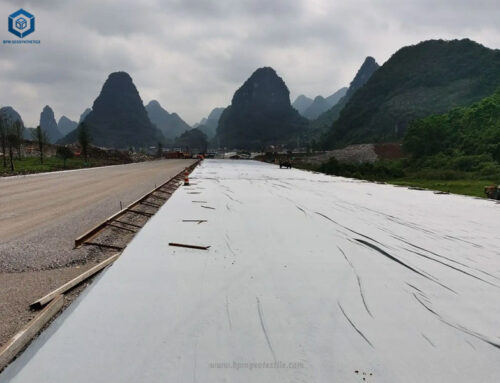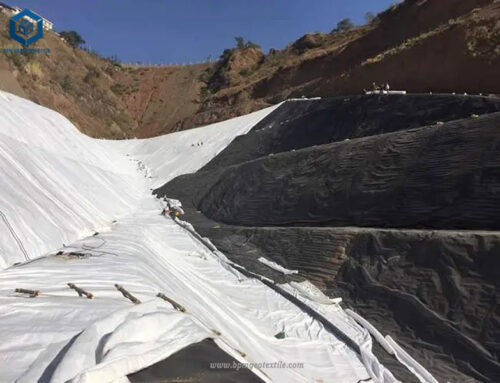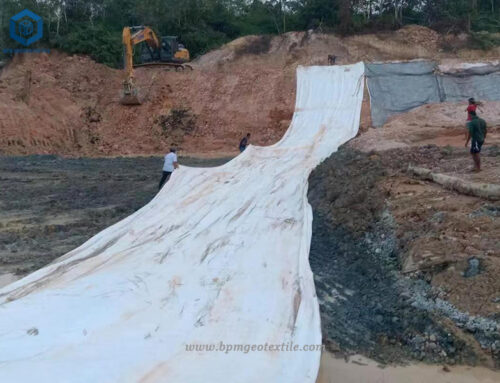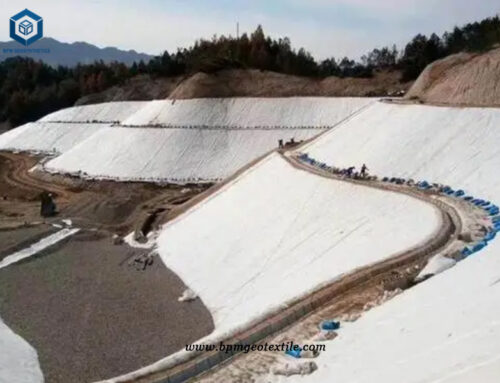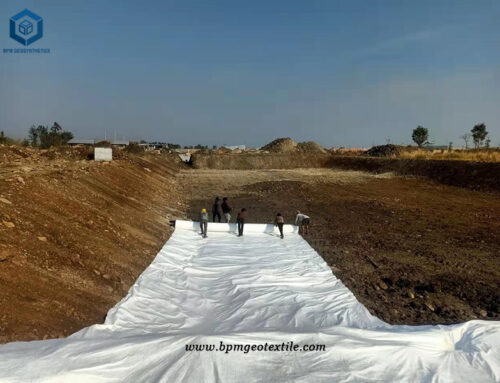Geotech fabric under gravel, also known as the geotextile fabric for road construction, is the permeable geosynthetics product which are widely used with foundation, soil, rock, earth, or any other geotechnical engineering-related material as an integral part of human-made project, structure, or system.
Case Study
- Location: Indonesia
- Product: 200gsm Geotextile fabric
- Application: Tailings
Issue
The Indonesian customer is currently constructing a road project. In order to prolong the service life of road reinforcement, the customer searched for our geosynthetic products on the website, found our email through the website, and learned that we are professional manufacturer for geotextile and geomembrane products, so he sent an inquiry to the company’s public email disk inquiry. At present, the customer has some doubts about the construction method and laying.
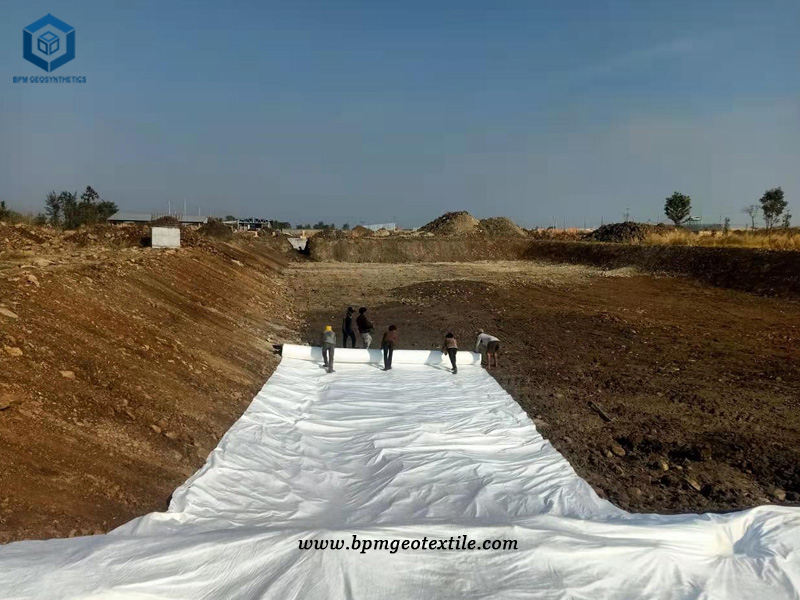
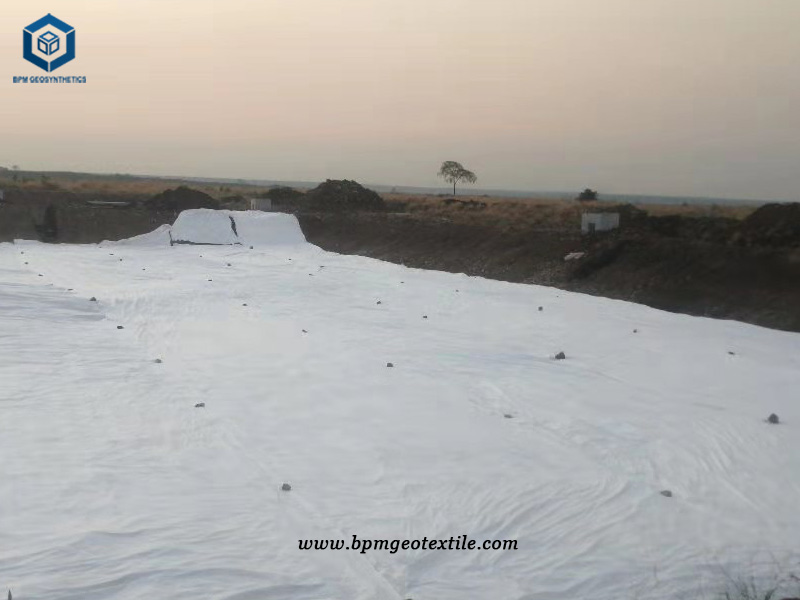
Construction method
1. Subgrade renovation
Before laying geotech fabric under gravel, the subgrade should be refurbished. First check the compactness of the roadbed, if it still does not meet the requirements, it needs to be re-rolled. After the compactness meets the requirements, level the subgrade surface, start from the center line of the line, and make a drainage slope of 4% to both sides. The surface of the subgrade is not allowed to be uneven, and the reverse slope to the center of the subgrade is strictly prohibited to prevent the subgrade from accumulating water. When over-excavation occurs in cutting excavation, it shall be backfilled with similar soil, and the backfilled part shall be compacted.
2. Ditch shoulder protection
During roadbed repairs, side ditch mortar laying and shoulder protection dry laying can be conducted. The subgrade side ditch mortar masonry uses M10 grade rubble, following stone masonry specifications. The width and height of the side ditch are constructed as per design requirements. Drain holes of ø100 or 100×100 should be placed every 1 meter on the subgrade surface, filled with filter screens to prevent erosion. Some sections of the embankment must adhere to stone masonry code, with a 50cm top width, consistent outer slope rate, and vertical inner side. After constructing the shoulder guards, the top surface is plastered with a minimum 5cm thickness of M10 grade cement mortar. Care should be taken to maintain the plastered surface and avoid stepping on it or placing heavy objects if the strength is insufficient.
3. Cushion laying
Cushion laying materials are medium and coarse sand. After rolling, the thickness of the geotech fabric under gravel layer should reach 10cm thick, and the relative density after compaction should reach more than 75%. 10-15 ton self-propelled vibrating rollers are used for cushion rolling, generally two times are sufficient, and supplementary pressure is required when the requirements are not met. The top surface of the cushion layer should also have a drainage slope of 4% towards both sides. During the laying of the cushion layer, if the content of material diameter above 2mm is >5%, it must be sieved. If there is a large material diameter during laying, it must be manually picked out or sieved. After rolling, the cushion surface must be smooth and flat, and no protrusions The ribs to prevent the geotextile from being punctured.
4. Geotextile laying.
Before laying the geotextile under the gravel, measure the centerline and draw side lines. The geotextile should be laid along the line, with a maximum deviation from the sideline of 5cm. Each piece should overlap the next by at least 50cm, and bonding methods can be used. Deduction items must meet or exceed material technical requirements. For lap joints, the outer edge should be under the inner geotextile, not on top. Smoothly lay the geotextile without wrinkles or folds. Damaged sections should be promptly replaced or repaired.
5. Laying of protective layer
After the geotextile is laid, the protective layer should be laid in time. It is best to lay the protective layer when the geotextile is laid. When laying the protective layer, the transport vehicle should not walk on the geotextile, but should walk on the paved protective layer, so as not to affect the laying effect of the geotextile or damage the geotextile. Other requirements for the laying of the protective layer are the same as those for the laying of the cushion layer, but no Leave a 4% drainage slope.
6. Paving of seepage soil
After the seepage soil is paved and rolled, the cutting section must be 10 cm thick, and the embankment section must be 30 cm thick. Water seepage soil laying and transportation vehicles cannot walk on the protective layer. Walk on the paved seepage soil so as not to affect the laying effect of the protective layer. For the paved seepage soil, the cutting section is generally rolled no less than twice, and the embankment section is generally rolled 4 to 6 times. The relative density of the permeable soil after rolling is required to be not less than 75%, and if it is unqualified, it must be re-rolled.
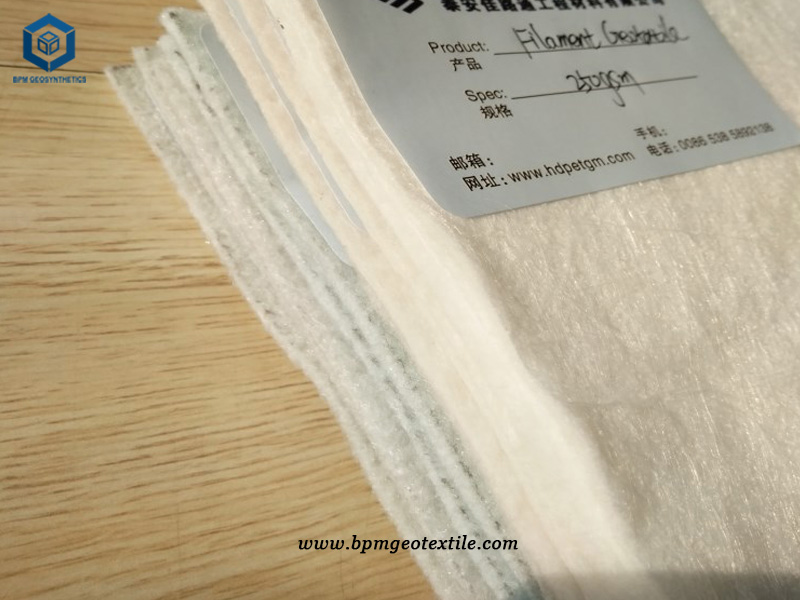

Benefit
The benefits of geotextiles for roadbed reinforcement projects: Light weight, good overall continuity, high tensile strength, corrosion resistance, good anti-microbial erosion, and convenient construction. The pore diameter is small, the permeability is good, the texture is soft, and it is well combined with the soil.
Geotextiles are used for laying construction of roadbed reinforcement works:
(1) Lay according to the full section of the bottom width of the embankment.
(2) Leave sufficient anchorage length on each side of the embankment.
(3) In order to ensure integrity, when the lap joint method is adopted for continuity, the lap joint length should be 0.3-0.5m. When seaming, the bonding width shall not be less than 50mm.
(4) During on-site construction, material damage must be repaired immediately. The joints of the upper and lower layers shall be alternately staggered, and the staggered length shall not be less than 0.5m.
(5) Try to avoid prolonged exposure and exposure to the sunlight.
Specifications of Geotech Fabric Under Gravel for Road Construction in Indonesia
- Total quantity–42000 squares meters
- Geotextiles specification – 200gsm
- Each roll size is 5.8m*100m
About BPM
BPM manufactures and wholesales many types of effective and states of the art geotextile, geomembrane, and other geosynthetics to over 36 countries. BPM geosynthetic products are widely used across a variety of industries including waste containment, water containment, aquaculture, industrial project, energy project and mining projects, etc. BPM main customers are from Australia, France, Sweden, UK, Hungary, New Zealand, Poland, Mexico, Ecuador, Brazil, Pakistan, Bangladesh, Thailand, Vietnam, Malaysia, Indonesia, Singapore, Philippines, Sri Lanka, India, UAE, Saudi Arabia, Qatar, Kenya, etc.
BPM is not only manufacturing best quality geosynthetic products but also providing professional design and installation service. OEM, ODM, custom development and fabrication are also available. If you have any questions or inquiries, please fill and submit the following form, we will reply as soon as possible.

